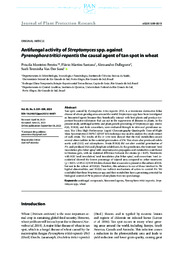Antifungal activity of Streptomyces spp. against Pyrenophora tritici-repentis the causal agent of tan spot in wheat.
Antifungal activity of Streptomyces spp. against Pyrenophora tritici-repentis the causal agent of tan spot in wheat.
Author(s): PEREIRA, P.; SANTANA, F. M.; DALLEGRAVE, A.; VAN DER SAND, S. T.
Summary: Tan spot, caused by Pyrenophora tritici-repentis (Ptr), is a worrisome destructive foliar disease of wheat-growing areas around the world. Streptomyces spp. have been investigated as biocontrol agents because they beneficially interact with host plants and produce important bioactive substances that can act in the suppression of diseases in plants. In the present study, antifungal activity and plant growth-promoting of Streptomyces spp. strains 6(4), R18(6), and their consortium, were evaluated through in vitro and greenhouse assays. The Ultra High-Performance Liquid Chromatography-Quadrupole Time-of-Flight Mass Spectrometry (UHPLC-QTOF MS) technique was used to analyze the crude extract of each strain. The results of the in vitro tests showed that the 6(4) metabolites caused several abnormalities in the conidial germination of Ptr. This strain also produced indole acetic acid (IAA) and siderophores. Strain R18(6) did not alter conidial germination of Ptr, and produced IAA and phosphate solubilizers. In the greenhouse, the treatment ‘seed inoculation plus foliar spray’ with streptomycetes propagules and metabolites contributed to biomass gain, with no statistical difference between the strains (p < 0.05). Treatments with 6(4) ‘seed inoculation’, ‘seed inoculation plus foliar spray’, and consortium ‘seed inoculation’ showed the lowest percentage of injured area compared to other treatments (p < 0.05). UHPLC-QTOF MS data showed that erucamide is present in the culture of 6(4), but not in the culture of R18(6). Therefore, this substance is one of those involved in Ptrhyphal abnormalities, and R18(6) use indirect mechanisms of action to control Ptr. We concluded that these Streptomyces spp. and their metabolites have a promising potential for biological control of Ptr to protect wheat plants from tan spot damage.
Publication year: 2023
Types of publication: Journal article
Keywords: Doença, Doença Fúngica, Mancha bronzeada, Pyrenophora tritici-repentis, Trigo, Wheat
Observation
Some of Embrapa's publications are published as ePub files. To read them, use or download one of the following free software options to your computer or mobile device. Android: Google Play Books; IOS: iBooks; Windows and Linux: Calibre.
Access other publications
Access the Agricultural Research Database (BDPA) to consult Embrapa's full library collection and records.
Visit Embrapa Bookstore to purchase books and other publications sold by Embrapa.

